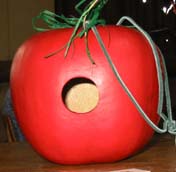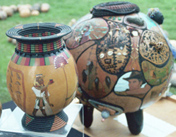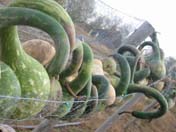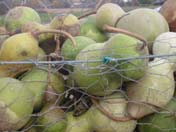|
Note: If using Outlook click the above bar where it says “Click to download photos” The photos are the best part! In this issue we are pleased to feature Artist Kelly Jonathon, Aboriginal painter, stone carver and gourd artist. We have an informative report on the California Gourd Societies 5th Annual Festival which was held Oct 22 – 23 in Arcadia CA. Also a tutorial on “How to use Gilders Paste” (Check out our Monthly Specials – a 20% saving on Gilders Paste!) Plus an excellent article on Wood Burning Tips and Pyro paper, a short tutorial on Green Peeling plus a Q & A segment! So grab a coffee or tea, read on and enjoy….
Gourd ornaments can quickly become heirlooms. To view gourd birds click here. Christmas is right around the corner and people are beginning to think about it. Mini gourd tree ornaments are the perfect gift for friends, family or co-workers. Minis are small & easy to handle - ideal for a childrens’ Christmas activity at the annual Christmas party.
Northern Dipper has Mini Bottle, White Egg and some White Ball gourds still available. 
To view these festive ornaments click here.
For Santas the Kettle gourd is a perfect shape. On your order in the comment section specify that your Kettles are for Santas and we will chose gourds with a nicely shaped “hat.” To view Minis & Kettles click here.
Beautiful rich colours – ideal for Christmas tree ornaments and Christmas projects. See tutorial below on how to use. Sale in Effect Nov 1 – 30. Must be shipped in the month of November. For available colours click here.
Apple Gourds - 25% off regular price. Make Apple birdhouses for the bird lover on your Christmas list! Sale in Effect Nov 1 – 30. Must be shipped in the month of November. For details click here.
PROXXON Tool Deals – Check out the Tool Deals Northern Dipper offers on the German Made Proxxon tools. Light and easy to manipulate. A wonderful gift for either yourself or a friend. For details click here. Kelly Jonathan - Painter, Stone Carver, Gourd Artist Kelly Jonathon’s introduction to gourds happened by chance. He was out for a drive, about ½ hour from his home, when he came across the Cherokee Gourd Show. After 1 hour he told his wife and infant daughter to go home, he was spending the day surrounded by hundreds of gourds. This gourd encounter opened the door to another medium that was love at first sight. Kelly has been involved in the arts his entire life and his Aboriginal culture is reflected in the art he creates. As a child he learned the Mohawk and Ojibwa languages from his Grandmother who would teach through pictures and the spoken language. As he got older he studied Fine Art and Graphic Arts and at one point was actively involved in the Headstart Program which is a preschool program offered in Canada. He has designed finely detailed rugs, which reflect Native culture and symbols and to this day the Headstart program use these rugs to teach children about their history. In working with gourds Kelly feels as though he has returned to his roots. Gourds, it is believed, were brought up to Canada, centuries ago, through the trade routes from the US. Gourds are 1 of the 3 (Squash) Sisters in Native culture and are used today in ceremonies and rituals. Kelly’s designs are taken from Nature; the animals, the earth, water, rocks, sky and the stars and the Moon. He does extensive wood burning and designs his own woodburning tips as well as brushes and dyes. He is still involved in stone carving and painting but it is gourds these days that are filling his studio. Kelly presently sells his art in Canada, the US and Germany and is finding that his original and uniquely styled gourds are finding their way into Collections around the world.
“Rough Gourd Rattle” From the Collection of Singing Dog Studio - Ed and Darienne McAuley Gourds In History Throughout history Purple Martins have worked in partnership with humans to control flies and other insects. Early Aboriginal Indians used gourds as houses to attract the Martins. The Europeans carried on this custom - and for the same reasons: flies. Throughout the 18th, 19th and early 20th centuries farmsteads, villages and towns throughout the eastern US used artificial nesting to attract colonies of Martins to their neighborhood for insect control. For more info on Purple Martins here are 2 good sites. Click here or click here.
Lynette Dawson’s "Native Drummers" Lynette has been working with gourds for 8 years and her Picture Trail is very diverse! To explore Lynette's work click here. Welcome to the California “Gourd Arts Festival” – A report by Margo McCall
David E. Snooks’ Washoe collection on display at the art gallery featured traditional gourds with a tribal twist.
Gourd festival season may be over in Canada, but it’s still going strong south of the border. The other CGS – the California Gourd Society – held its fifth annual Gourd Arts Festival at the Los Angeles County Arboretum & Botanic Garden Oct. 22-23. Gourd lovers from throughout the region gathered in the warm but hazy sunshine to listen to flutist Xavier Quijas Yxayotl, view gourd art exhibits, attend demonstrations and browse vendors’ stalls. The festival kicked off with the “Outta Your Gourd” dinner to the backdrop of a pond filled with illuminated floating gourds. Colorful pieces from California gourd artists David Snooks, Merilou Jenkins and Bonnie Gibson were on display in the festival’s inaugural art gallery. But they had some competition in the form of the arboretum’s resident flock of peacocks. The brightly plumed peacocks strutted their stuff among the vendor stalls, vying for attention with gourd drums and African kalimbas and the sellers of gourd paint, gourd beads and gourd books. Another first for the festival this year was the Iron Gourd Competition,
The Iron Gourd Competition If the California Gourd Society has its way, making gourd art just might become the next Olympic sport. For training, artists might want to sign up for the Iron Gourd Competition, a contest that requires artists to complete a piece in 13 hours, using prescribed materials and in full view of spectators and fellow gourd artists. Seven brave artists signed up and Oh yes, each artwork had to feature beads, feathers, ribbon, the color purple, wood-burning, paper clay and babies. Although judge Margo Farrin said she had a difficult time determining a grand prize winner, in the end she picked Rebecca Black’s “Butterfly Dance.” Margo, owner of Farrin O’Connor Design Studios of Pasadena, said she considered creativity, innovation, overall design, craftsmanship and the extent to which gourds predominate. Rebecca, who is just recovering from nine months of cancer treatment, said she chose butterflies because they are “light, colorful and flow with the air.” Angela Briggs’ “Khatiti” – which the artist described as being “full of good juju” – took the People’s Choice award. Despite the time constraints, most of the artists said they felt little pressure. Michael Wong said he changed his project three times before settling in on “Hawaii Aloha,” a triple gourd sculpture modeled after a three part song. “I tried to keep the feeling of Hawaii in what I was doing,” he said. Betsy Roberts said she didn’t worry at all. “I coil, I have fun. Whatever happens to the gourd happens to the gourd,” she said. Larry McLelland said he thought he was finished with his “Spirit Mask” an hour before finishing time. Then he suddenly realized he hadn’t yet used the required beads. Not all of the artists were casual and carefree. Kathy Riker said she planned out every step of her piece, which she called “Mother Earth” and finished in 12 hours and 58 minutes.
“I was more organized than Donald Trump,” she said. A Special Thank You to Margo McCall for submitting this article. Margo is a Journalist and Gourd Art Lover who makes her home in CA. For more info on the California Gourd Society click here. Tutorial: Faux Raku Using Gilders Paste & Crackle By Catherine Devine 
This gourd has been painted, crackled and colored using Gilders Paste. The gold decoration running around the middle is stenciled Gilders Paste. Preparation: Clean and sand the gourd inside and out. Basecoat the exterior with a wash of copper or gold, and add a coat of black, blue or burgundy acrylic to any area you want to color with Gilders paste. Once the paint has dried well (either overnight, or using a hair dryer) apply a coat of Crackle Medium. (I used Jo Sonja). If you use a thin coat, you will get fine crackle. If you use a thicker application you will get larger cracks. When the medium has dried, apply a thick coat of Briwax or paste wax to the outside. This will allow you to remove the Gilders paste from areas you don’t want colored, and protect the sealed coating from the mineral spirits. Method: Select your colors. Raku colors are black, gold, copper, and iridescent blues, greens, and purples. Using a soft cloth dampened in mineral spirits, pick up a color of paste. Starting with a darker Gilders paste (black or dark blue), cover all the painted area by smoothing on the paste in a circular motion, making sure to cover the crackle area well. Overlap the edges of the painted area slightly. You are eventually going to cover this up entirely. Choose another darker color (plum or dark green) and begin dabbing color on, heavily near the edge of the paint, fainter farther down. Your cloth will need to be dampened in mineral spirits to get a wetter application. Continue to add lighter colors (slate, African bronze) until you achieve the raku effect you want. The last coat will be a bronze or gold, concentrated on the crackled area. You can add color using a paint brush dipped in mineral spirits. Allow the paste to dry and then buff. The whitish residue left from the mineral spirits will be removed, along with a bit of the metallic colors. Add more gold and copper as required and buff again. Use the copper paste to soften any areas that have gotten too dark. You can also use diluted gold or copper paint to drip along the edge and allow it to run over the colours, or sponge it on for highlights. Using a simple stencil cut from paper, add a design over the finished gourd to your liking using either the Gilders paste or the gold or copper paint. Let dry and buff gently. The Gilders paste is a finish so nothing extra is required, but you can spray it with a light coat of Varathane. However, you do need to seal the inside. You can use the Briwax (floor paste wax) or Varathane. This will help to keep the gourd from absorbing moisture and lifting the finish. Be sure to seal the cut edge of the rim as well.
Catherine Devine teaches this technique among others throughout the US & Canada at various Gourd Festivals and events. To view more of Catherine’s superb art click here.
Pyrography Tips by Brigette Thompson When the good folks at Northern Dipper asked me to share my thoughts on pyro pens in this newsletter, I initially hesitated. Every pyrographer has a slightly different style and therefore uses their pens somewhat differently. How could I possibly address all of the variations that I have witnessed that work equally as well or better for other artists. After some thought, I decided that I couldn’t. But what I could do is show you what I use and recommend to our customers and students. You may have a pyro tip that you swear by that I have not mentioned, or you may totally disagree with what I use. Whatever the case, I am a firm believer that if it works for you and you’re happy then doesn’t change a thing. All of the tips I recommend are manufactured by Razertip Industries Inc. Not only do they manufacture one of the best pyrography systems on the market, they provide outstanding warranty service and are 100 % Canadian. The identification codes that follow are those designated for Razertip products.
Left To Right: HD5MP Medium Spear Shader, HD30M Medium Spoon Shader, F9 Writing Tip, F5S Small Spear, F9G.17 Gourd Cutter, F99.015 Ball Stylus 1.5 mm, F7M Medium Skew HD5MP – Medium Spear Shader Perfect for shading large areas, this profile is the backbone of my pyro kit. Whether I am burning on gourds, paper, leather or wood, this is the profile I use most often to create shadows. The tip is bent at approximately 45 degrees and comes to a soft point making it ideal to get into hard to reach corners. The blunt finish gives your “burn” a softer look. I also like this profile because it is versatile. You can turn it on its side to make long curving hair and fur strokes or shorten up the stroke and make straight lines for short hair or fur. In addition you can turn the tip over and using only the point to create dotted textures for a soft “pointillism” technique.(stippling) *** Remember when using any heavy duty tip, (as this one is) you must use a heavy duty cord. Razertip identifies their heavy duty cords with red coloured ends. I only use a heavy duty cord to avoid any confusion. F7M – Medium Round Skew This is also a staple in my pyro kit. This tip is also available in a larger size and two smaller sizes. I prefer the medium for the size of work I generally do, but have used the small on occasion for finer detail. The skew is great for detail work on hair, fur and feathers. The blunted tip creates a softer look and is not quite as sharp as the #1 Regular Skew. Both tips can cut into the gourd skin.
Shading tips come in a variety of styles. F9 – The Writing Tip I think Razertip should change the name of this profile, since they now manufacture a better tip for cursive writing that I will mention later. However this tip is indispensable as a gourd drawing tip. Use it everywhere and anywhere that you don’t want the tip to cut into the gourd. The rounded end lets you turn in any direction and still maintain contact with the gourd. This profile is excellent for marking design lines and creating soft textures when you need a wider, softer line. Because the tip sits on top of the gourd skin (doesn’t cut in) you have to pay attention in order to burn neat lines This is exactly what makes it ideal for difficult curves, soft lines, animal eyes, and filling in small areas. It is an absolute necessity for gourd work. This tip comes in smaller sizes but if you want larger, you have to go to the F17M or F17L. Both of these give a nice wide burn. This is the profile that should be re -classified as the “writing” tip. When using it to create cursive writing, the tip flows effortlessly along the surface. It corners like a Ferrari and holds a fairly consistent heat even at the speeds most people write. This profile is also excellent for tracing lines and creating a soft shaded effect for small areas. This is the smallest size which I find the most versatile, but it also comes in sizes up to 5.5 mm. This profile is also great for shading and drawing. This tip is vastly under appreciated. Pyro artists just need to take some time to have fun and experiment with this profile. You will be pleasantly surprised. F5S – Small Spear
This is an absolute must if you are trying to detail an eye or other small intricate area. It is a sharp point and will sink into the gourd surface but invaluable for burning fine, crisp lines. Also great for a cross hatching style of shading. F9G.17 Gourd Cutter This is a tempered tip for piercing gourds. The elongated surface burns straight into the gourd. Great for cutting out those tiny little holes or cleaning up a corner that your mini jig saw couldn’t reach. Simply turn the heat to the required temperature and hold the tip against the gourd. I will burn straight through to create fretwork or lacy style holes. The heat travels from the base to the tip so by moving this tip around in any pierced area of your gourd, you will burn away anything it comes in contact with. A word of caution – this profile does create a lot of smoke. It should not be used without respiratory and eye protection.
Whatever tip profiles you choose and whatever your technique, never lose sight of the most important aspect of pyrography – Have Fun!!!
Brigette & Moe Thompson are the owners of Thompson’s Woodcarving. Their speciality is carving tools and pyrograghy kits. Knowledgable and easy going, Brigette and Moe will welcome you whether you are a novice or a professional. To purchase the above mentioned tips or other fine products click here. Gourd Growing In November Harvesting your gourds will be a priority this month. Here in Southern Ontario we have had a couple of light frosts; enough to kill off most of the vines but not quite enough to make the gourds visible underneath all the weeds. The most important thing at harvest is to get them up off the ground as they need good air circulation during the winter, particularly in the snowy climates. Get onion bags and hang them from your trees and leave them for the winter. Or put them up on pallets in a cold garage. Do not however take them in your house and put them on your mantle!
Royal and Annie Kat enjoying the day.
These gourds had to be lifted with the tractor. Some of these will make incredible drums or fruit bowls. After harvest clean up all your vines and burn if possible. They may contain insects or disease and will save a lot of work in the Spring! Always keep your gourd patch clean from debris.
At Northern Dipper… We were rained out on the days we had scheduled for harvest in Oct. In the end however Mother Nature favored us with 16 C (60F) sunny skies and we got the harvest done. It was our best year ever with astounding numbers and quality gourds. Now the field needs a good cleanup, the irrigation system and various hoses have to be brought in and we had better get our rakes out! And onward we march…. To see photos of growing gourdsclick here.
Green Peeling – It’s Easy!
The green gourd on the left has a naturally green inner shell while the right hand gourd is drier; therefore the inner shell is brown. Some gourds will weep once green peeled. Store on a thick layer of newspaper and wipe down weekly. Green Peeling is simply the process of scraping off the thin waxy outer coating or skin (the epidermis), which covers the gourd. Using a knife with a straight blade gently scrape the epidermis off. Be careful - do not scratch or mark the gourd shell. Wipe with a mild solution of water and bleach or dish soap every week. Many carvers like to green peel as it gives them a clear canvas to work on in the upcoming spring. Green peeling will also hasten the drying process. Green peeling can happen any time after harvest. Some gourds will shrivel and crack during this drying process because the gourd wasn’t mature. Peter sums it up in this way, “ Gourds are like people. Sometimes they look mature but are not. You take your chances.” Keep your eye on your green peeled gourds just in case they are not! It will take a few months to find out. We’ll follow the drying process of these gourds in upcoming newsletters to see how they turn out.
Harvesting Cauliflower Cauliflower is a very labour-intensive & back breaking crop. Mid-season the leaves have to be tied tightly around the head in order for the cauliflower to stay white. At harvest the leaves are cut from the head to prepare for the marketplace.
Q&A Hello Northern Dipper, I enjoy receiving your newsletters. I am hoping that you will have further information, in your next issue, on gourd growing in Guatemala. I have a small property in Jamaica, one acre appx.) and I would like to try growing some gourds there. I have two calabash trees on my property; I do not know what to do with the calabashes which are quite small. I am entertaining the idea of making jewelry with them. I am interested in growing gourds which could be used as containers for water (large gourds) and which would be good for artistic endeavours. My property is located in a small, rural village and I hope to encourage the villagers to add their artistic know how to the gourds. Could you recommend the types of gourds that would be suitable for the situation mentioned above and when I should be planting the seeds? I have been doing my due diligence on growing gourds but I need some expert advice. Thanks.JB
Hello JB, Thank you for your Email. Regarding you growing gourds in Jamaica the best thing for you to do is stand on your back porch, cast out your arm & toss those seeds into the wind! They will grow. Seriously the climate is a natural for gourds and they are guaranteed to do well. We generally plant the seeds in Guatamala in the Spring just before the rainy season.The only thing I might suggest is to prune your vines at a reasonable length (10’ – 15’) Suggested types for containers and art would be Kettle gourds, Bottles, Bushels and Dippers.
I applaud your plan to involve the local community in your endeavors. There are many organizations such as Ten Thousand Villages which may be interesting in selling that art which would put money back into the local economy. Keep in mind that functional art has a bit of a leading edge in the marketplace.
Good luck to you! Northern Dipper NEXT ISSUE: As most of you know we grow gourds in Guatemala. One reason is that we get great gourds, the other reason is that the people are very poor and it puts money back into the local community. Next issue we are going to delve into the lives of the Mayan Indians in Guatemala and what a small non-profit Canadian organization is doing to help these people become more self-reliant. Also we are very happy to present Quebec artist France Benoit. You will find her fascinating. (I just wish I could convey her infectious laugh.) As well France will be doing a Tutorial on Father Christmas. We did not get to the beaded gourds done by the Huichol Indians of Mexico this newsletter so it will included next month. Closing the year: a final grow report, gourd sightings and more. Until then…. Pam Grossi & Peter Bell
Back issues of our newsletter Gourd Fever are on our Website. (Sorry no photos) If you have missed any issues there are some interesting tutorials and grow information you may want to check out.
PS If you have any stories or ideas that you would like to contribute to this newsletter please send to info@northerndipper.com |
|











































